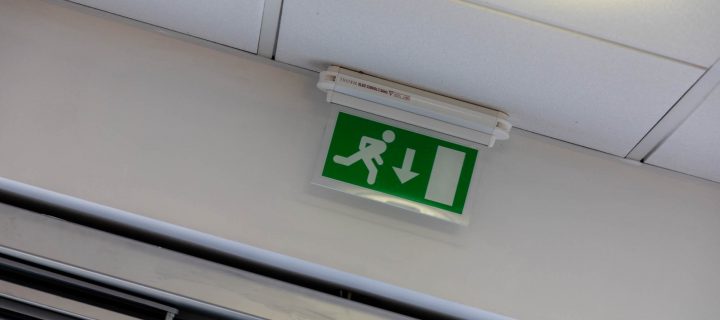When a fire breaks out in a building, one thing that can be easily compromised is the power supply. A fire can be a cause for panic by itself, but the lack of light in a building during this emergency can make things much worse. So how are buildings prepared for this eventuality?
This month at TVF (UK) Limited, we’re going to take you through exactly what emergency lighting is, the different types you might encounter and what the legal requirements are regarding this essential part of your infrastructure.
What is emergency lighting?
Emergency lighting is a system that kicks in automatically in the event of a power cut within your building. For example, if a fire breaks out and the power fails, this system will come on in place of regular lighting.
The reason emergency lighting is so important is that it helps anyone in the building at the time to evacuate safely. Without adequate lighting, some people may panic or become disorientated, putting them in danger. A total blackout could also lead to injuries when people can’t see their way through a building, particularly where any stairs or steps are involved or where people are unfamiliar with the building layout.
There are many different types of emergency lighting, which we’ll cover shortly, but here are four simple reasons you should have emergency lighting in your building:
- For the safety of everyone in your building
- To minimise panic for anyone in the building
- To help first responders navigate your building
- To keep your business legally compliant
The different emergency lighting types
Depending on the type of building and the type of industry you operate in, there may be a different combination of emergency lighting types recommended for you. Here are some of the most common types of emergency lighting found here in the UK:
Escape route lighting provides lighting for an exit route out of your building. You’ll find that the emergency exits and fire escapes will also be illuminated to help people find the best route out.
Open-area emergency lighting for those larger, open-plan areas where people might panic if things suddenly went dark. This type of lighting allows anyone in these areas to see their surroundings without injuring themselves as they look for their nearest exit.
High-risk task area lighting is slightly more specialist, since it’s positioned in areas where there is dangerous equipment, machinery or substances in use. By illuminating these areas when there is a sudden loss of power, employees can safely stop their work and shut down anything they were currently involved in before exiting the building.
Standby lighting is a simpler form of lighting and is a general backup for when your building loses power but you need to carry on working.
Are there legal requirements for emergency lighting?
Yes, there are legal emergency lighting requirements for businesses and commercial premises. The Regulatory Reform (Fire Safety) Order 2005 outlines the requirements for your escape and evacuation paths. The specific wording from article 14 of the order is as follows:
“emergency routes and exits requiring illumination must be provided with emergency lighting of adequate intensity in the case of failure of their normal lighting.”
For this reason, it’s important to ensure your emergency exits are highlighted by lights that can remain on in the event of a power failure in your building. You may also find further guidance for escape lighting in the British Standard BS EN 1838.
Where do I need emergency lighting?
Rarely are two buildings the same. You may have different requirements across a portfolio of properties, but here are some of the areas you’ll typically need emergency lighting for in commercial premises:
- By your exit doors
- By your escape routes
- Where your corridors intersect
- Above your external escape routes
- Above your the final exit door
- In your stairwells for each flight
- Where there is a change in the floor level
- By your lifts
- By your fire alarm call points
- By your fire safety equipment
- In any windowless rooms and toilets larger than 8m²
For more expert information and advice on emergency lighting, no matter what sector you operate in, look no further than the team here at TVF (UK) Limited. We serve High Wycombe, Watford, Slough and surrounding areas to help you protect lives and remain legally compliant. Contact us today and talk to us about your emergency lighting needs.













